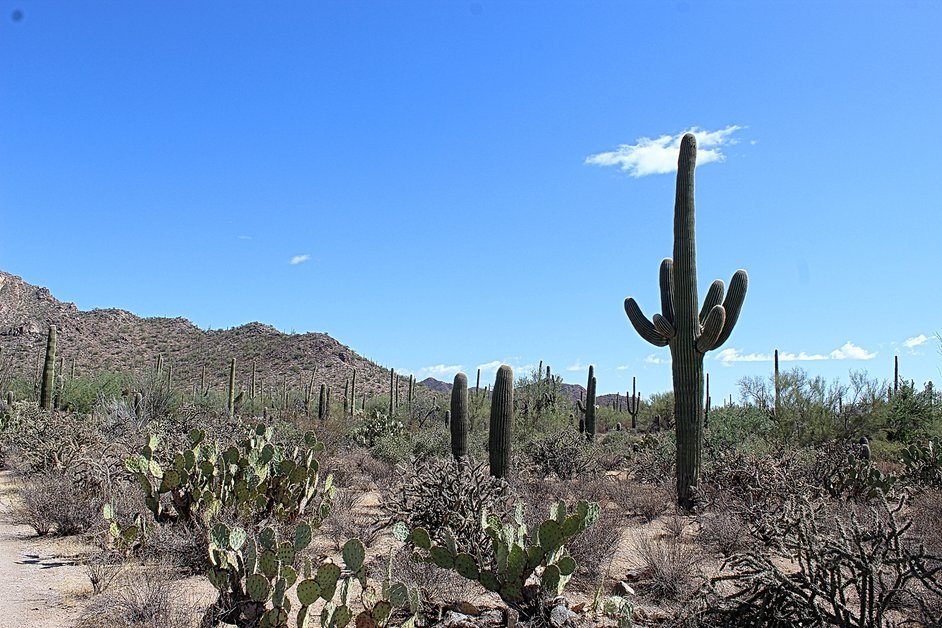Saguaro National Park, located in southern Arizona near Tucson, offers visitors a unique glimpse into the vibrant desert landscape dominated by the iconic saguaro cactus. The park is divided into two districts—Rincon Mountain District to the east and Tucson Mountain District to the west. Each area provides diverse scenery, cultural significance, and opportunities for outdoor enthusiasts and travelers with pets.

In this guide, we’ll cover the park’s background, details on its famous cacti, Native American history, and Spanish/Mexican influences, along with what to expect when visiting with a dog.
Saguaro National Park
Saguaro National Park was established in 1933 to protect the majestic saguaro cactus, a symbol of the American Southwest. Saguaros are native to the Sonoran Desert and are known for their towering presence and distinctive arms, which begin to grow after 50-75 years of age. These cacti can reach heights of over 40 feet and live for up to 150 years. Their slow growth rate and longevity make them essential to the desert ecosystem, providing habitat and food for birds, mammals, and insects.
The park’s landscape extends beyond saguaros, incorporating a variety of desert plants such as ocotillo, mesquite trees, prickly pear, and wildflowers. The two districts of the park offer different experiences, with the Tucson Mountain District featuring dense saguaro forests and the Rincon Mountain District offering higher altitudes with additional plant diversity.
Native American History
Long before it became a national park, the land that now comprises Saguaro National Park was home to several Native American groups. The Hohokam people, who lived in the region between 200 and 1450 CE, left behind evidence of their presence, including petroglyphs, pottery, and irrigation canals. The Hohokam were expert farmers who cultivated corn, beans, and squash in the harsh desert environment, using sophisticated water management systems to sustain their crops.
After the Hohokam culture declined, other indigenous groups, such as the Tohono O’odham, settled in the area. For the Tohono O’odham people, the saguaro cactus has spiritual significance. They regard the saguaro as a relative and honor it in ceremonies, including the annual saguaro fruit harvest, which celebrates the monsoon rains. Visitors can see remnants of ancient rock art in the park, offering a glimpse into the cultural significance of the land for Native peoples.
Spanish & Mexican History
The arrival of Spanish explorers in the 16th century marked the beginning of European influence in the region. Spanish missionaries, including Father Eusebio Kino, established missions in southern Arizona, seeking to convert the indigenous people to Christianity. One of the oldest missions in the region, Mission San Xavier del Bac, still stands near Tucson, showcasing the Spanish colonial influence in the area.
The region that includes Saguaro National Park became part of Mexico after gaining independence from Spain in 1821. However, following the Mexican-American War, the area was ceded to the United States under the Treaty of Guadalupe Hidalgo in 1848 and finalized with the Gadsden Purchase in 1854. Today, visitors can still see the influence of Spanish and Mexican culture in the area’s architecture, place names, and cuisine.
The Saguaro Cactus: More Than Just a Symbol
The saguaro cactus (Carnegiea gigantea) is the largest cactus species in the United States and a keystone species in the Sonoran Desert. These towering giants serve as critical habitat, with their branches and flowers attracting birds such as Gila woodpeckers and white-winged doves. Saguaros bloom in the spring, producing creamy white flowers, which are the state flower of Arizona. In the summer, the flowers give way to red fruit, which provides nourishment to desert animals and indigenous communities.
Saguaros grow very slowly—just an inch or two in their first ten years—and they only grow arms after several decades. It’s estimated that a fully grown saguaro can hold up to 200 gallons of water, making it well adapted to survive long droughts.








Visiting Saguaro National Park with a Dog
Bringing your dog to Saguaro National Park is possible, though visitors must follow certain rules to protect the environment and their pets.
- Paved roads and picnic areas: Dogs are allowed on park roads, making scenic drives a great option. You can also take breaks at picnic areas along the way.
- Desert Discovery Nature Trail (Tucson Mountain District): This short, informative trail is dog-friendly.
View on Google Maps
Tips for Visiting with Your Dog
- Leash requirement: Dogs must remain on a leash no longer than 6 feet at all times.
- Avoid the heat: Visit during cooler hours and bring plenty of water for your dog.
- Paw protection: Use booties or paw wax to protect your dog’s paws from hot desert ground.
- Wildlife caution: Keep your dog close to avoid disturbing wildlife, such as rattlesnakes or javelinas.
Scenic Drives and Activities
- Bajada Loop Drive:
A 5-mile unpaved loop with scenic overlooks in the Tucson Mountain District.
View on Google Maps - Cactus Forest Loop Drive:
An 8-mile paved drive with panoramic views in the Rincon Mountain District.
View on Google Maps - Sunset at Gates Pass:
A popular spot to watch the sunset.
View on Google Maps

Best Times to Visit
The best time to visit is from October to April, when temperatures are cooler. Spring also brings wildflower blooms, adding color to the desert. Avoid visiting in summer, as temperatures can exceed 100°F (38°C).
Park Regulations for Dog Owners
- Dogs are allowed only on designated roads, parking areas, and the Desert Discovery Nature Trail.
- Always clean up after your pet and dispose of waste properly.
- Limit time outdoors during hot weather to prevent heat exhaustion.
Saguaro National Park offers a unique opportunity to experience the beauty and history of the Sonoran Desert. Although some trails are off-limits to dogs, there are still plenty of scenic drives, picnic spots, and short trails where you and your pet can explore. With proper planning, your visit to this desert wonderland will be both safe and enjoyable for you and your furry friend.
So grab your leash, water bottles, and camera, and embark on a memorable desert adventure at Saguaro National Park!




